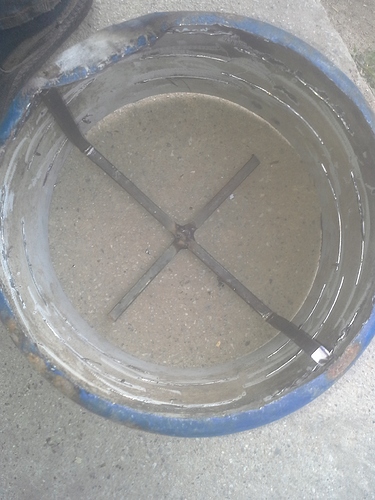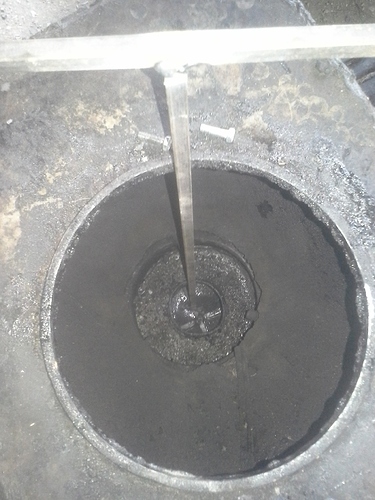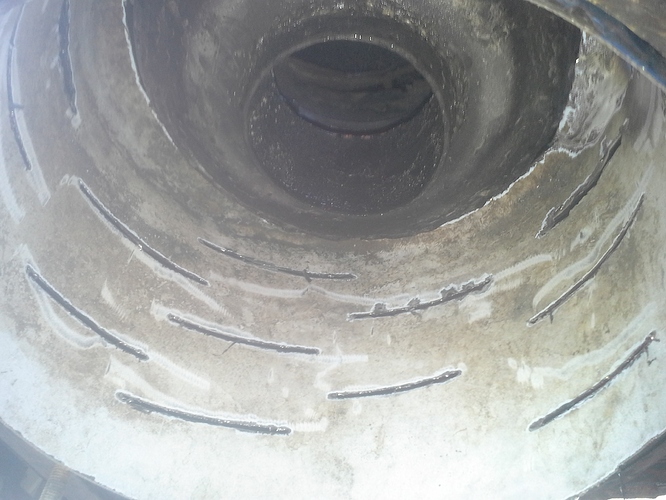Nope, nothing yet. A rather cold spring so far.
Typical last few weeks +5C in daytime and -5C during the nights.
Hi, Kristijan!
22.4.2017
“Some aftercleaning”: Your total entrance air area is, in accordance with your notes = 4,688 cm2.
This would (at WOT) apply for a cold air velocity of 15,36 m/s if blown straight in,
but now a good 3/4 of the air is slowed down by the broad gap full circle metal rings = “ring of fire”!
Broad gap = slower flow.
The upper 3 nozzles are unaffected by this.
Still, with an expansion by preheating of the air, a good gasification seems to result.
Max, you are right on the numbers! My fault.
As for the velocity of the ring of fire nozzles, l think the forged rings dont influence much. They are spaced about 10mm apart, with a 3mm nozzle in between. The purpose of them has been borrowed from Mr. Wayne, they shuld work as heat sinks to protect the firetube around the nozzles.
But l now see the importance of what was told to me a while back, the thing about gasifiers being female and the lower part being satisfied. Wery true!
The fact is, on this sistem, the oxy zone realy isnt wery special. Its just a oxy zone still. But l think we all (at least l did) underestimated the reduction zone. Afterall, this is where the magic happens, right? 
We have to put more effort there.
Ok, my share in the reduction zone knowlidge soup:
You can see the amount of char in the system. About a liter oxy zone and 20l of reduction zone. About half of that is useable char reserve, there for heawy acceleration and similar (sort of like a WK).
Its interasting, althugh ash did build up in the system, it was all located at the wery top. The active reduction zone is ash free.
Thus, power and performance were still mildly effected, but the a/f setting did require a stronger setting.
Thanks Kristijan!
A very good video.
If I understood this correctly most of the clogging ash was found on its way to the cyclone, caught by your perforated plate/screen. Is this screen possible to remove? If so, do you think it would be possible to run without it? Maybe the char will stay put and only fines and ash are light enough to fly. When bigger char starts to show in the cyclone - time to empty a smaller amount from the dump. That is kind of what I do. Just a thought.
Hi, Kristijan!
23.4.2017
You seem to have skipped the siporex bottom cover!
Two suggestions:
1.
Increase the restriction diameter from 90 → 100 mm.
Make an inner wall for condensing-circulation inside the silo + gutter and drain, then use the current net as “top-hat” (only one layer!) over the side char. Less plugging by not breaking the gasstream.
Don’t go too low with the gutter, to avoid re-boiling; more than 150 mm over the nozzles…
Jan,
l put the perforated plate in later becouse without it the upstream of hot gases emidiatly started to suck large amounts of char in the cyclone. So much it plugged everything, cyclone and cooler, preventing ANY gas flow trugh the system. Ha, you shuld see what happend to the hayfilter. Imploded to a flat plate becouse of the high vacuum 
Max,
l saw no need for it. Eaven after a hard pull l can hold my hand on the reduction lid.
Why do you suggest goeing to a bigger restriction?
The other thing l will do.
Hi, Kristijan!
25.4.2017
The reason is: One of your late videos show a heat-damaged contour of the restriction “mouth”. So the heat developement/oxidation volume can be “eased off” a bit to gain more lifetime and less pressure loss.
A small, but positive gain, if it is correctly assessed.
Especially in the high end, without jeopardizing the low end (of loading).
You have the velocity/area outline!
Ha, happened to me too. I tried to brace it with wooden crisscross but ended up making rings of rebar to reinforce the barrel. That’s holding up so far.
Max,
yeah its a mild steel 3mm cone, honestly l thod it wuld burn out faster.
The original idea was to put a SS insert in this welded in cone, to make a restriction of about 80mm to avoid tar, while have a disposeable restriction. But this one turned out well, might try your idea too, but first l have to wait this one burns out completely 
Jan,
l copyed your idea, hope you dont mind. But l used 6mm rebar, a bad idea  ended up with a big mess of imploded plastic and bent iron.
ended up with a big mess of imploded plastic and bent iron.
But l salvaged the barrel with a help of some boiling water. Not a easy job repairing it. l think l will rather go with a criss cross style reinforcement.
Emptying the reduction every 500-1000km is not hard, but unnesessery. So, in this spirit, and following Maxs guidence (sort of  ) l made a modification today.
) l made a modification today.
The new reduction is slightly smaller in diameter, and has gas exits trugh the sides allso.
There is a “slag buster” in, operated from the top, with a special pokeing rod. Just rotate it a couple of times when slag starts to form, at least thats the plan.
bottom up wiew. Without the slag buster.
So far, it works ok. The plan was not better performance, just longer, constant performance. But interasting, acceleration is much better with this sistem, top speed slightly decreased and railtemp slightly higher. I am curious how longer runs look like.
Hi, Kristijan!
13.5.2017
As expected!
A free’er and larger outblow “grating” surface lets gas out easier with less clogging, but to the price of lesser active char volume. The lessened volume gives less top speed, when the oxidation zone grows a bit down trough the restriction… (which can be bigger…)
How much has the top speed gone down on flat open road?
Congratulations anyway! Greetings from Argos! Had a direct connection with Chris via Skype. The Chrome Hangout worked after a few tries to Canada, Terry L.
Have a Nice weekend!
Max,
Yes, this was my thinking allso. If the slagbuster works, its a fair price thugh.
Not sure on top speed yet, need to go on a highway. I think l culd get by this with burning smaller fuel thugh. Will see.
Hi Kristijan,
The above kind of answered my question. I was meaning to ask you about ash/slag in your new reduction. Does your slag still end up mainly on your screen towards the cyclone. Do you still use the screen? If so, how do you reach it from above with that buster?
Max,
You run this kind of big char pile reduction. How does your system handle ash/slag? Or are you using the old style sifting grate? Do you use any form of screen not to blow char into the cyclone?
Hi, Jan-Ola!
13.5.2017
There seems to appear no slag! The char is heavily loaded with soot and ash. Maybe the heavy soot content is hindering ash to sinter into slag bits?
The “grate” is actually a perforated sieve plate, only letting down small particles and grains.
When emtying the bunker and heavily banging the sieve from below, a vast amount of soot and ash is “flowing” down. The main part is soot and small char grains.
The sieve has “full diameter”, meaning that very little can drop over the edge. So this is not a blow-through grate.
Full diameter to the outer mantel “skin” cylinder where the ash hatch is.
It then takes ~1,5 hours of open road driving to restore normal reduction conditions. Until then, the gas appears weak, not giving normal top speed.
Egg-sized fuel gives the best “Autobahn” speeds >110km/h, but cigarett box-size works well in town and mixed driving.
Conclusion: A proper grate will (at least as a narrow-diameter blow-through type) blow down the soot and small char, leaving the ash flakes free to melt into growing slag bits…
Slag meltingpoint!
Kristijan may avoid slag melting by increasing the restriction diameter in small increments…
Is it only about gasifier housing size and velocities or…
Hi, Jan-ola!
13.5.2017
I forgot that part, sorry!
No, there is no kind of “filtering”, but the run between the silo and the outer mantel is rather high, so the vertical separation works good Imbert style.
The cyclone bottle includes very seldom any noticable charbits.
Jan,
A bit to soon to anwser that one, only burned one hopper with it, but based on the fact slag only formed on the holes, the slagbuster sweeps all the holes now.
A bit of a explanation what l am actualy dealing with. On my first gasifier (copy paste yours) l had hard, glass like slag formingon on the grate. Now, the slag is more like fluffy cookies of ash. Wery britle, hard to hold without crushing it. I think most gasifiers wuld make this, but you guys poke a bit with the pokeing rod and its gone. I cannot acces it, so thats the reason for the slagbuster.
In normal operation no slag forms. The ash gets blown trugh the char. But, when my wife has things to do in the city, and we drive, stop, drive, stop… Ash builds up, then more ash builds on that ash, bakes or sintres on a hard pull and the proces repeats. At least thats my theory.
Same as I get on the grate when idling around too long.
Showed a friend around small low speed gravel roads in cottage areas the other day. We ran almost a full hopper down and ended up constipated. The grate most likely got covered with that stuff. I didn´t notice the high vacuum until i was trying to go WOT on our way home. I turned the grate a bit with the poker at next lightup and was back to normal.
The reason i keep asking is I think I´ll will have to go your reduction route if I´m going to try a low build for a sedan in the future. It would be good to get an idea of what it takes in terms of dimentions/velocities to run an unattended huge charbed.
Please keep us posted on your findings or if something unexpected happens.
Oh, how far up is your outlet positioned, counting from the firetube/reduction bell´s lowest point?
I wait patiently for the title “JOs wood powered sedan” or similar to pop out 
For now, l can say the ride is much smoother and sharper, but l do miss the short overpulling capability of the before full diameter reduction. Before, l just shifted down and pressed the pedal and the engine gave off a lot of short term power without overhesting anything. Thats gone now. Such plays quickly start to get hot on the rails. I wuld say go full diameter with sort of a bigger slagbuster, or likd Max, position the gas outlet higher.
The outlet is just on top of the charbed, if you draw a plane where the restriction ends in to the reduction, about 5 cm higher is the outlet.
If you look at the top picture showing the new reduction basket with the slag buster, you cansee one part of the top hammered flat. Thats to fit under the gas exit.
Hi, Kristijan & Jan-Ola!
One can also use 2 diametrically opposed gasoutlets to decrease the local succing action…



